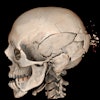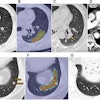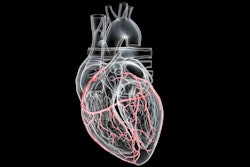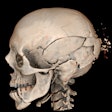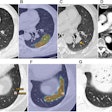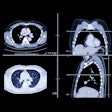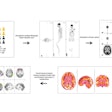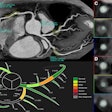An AI tool designed for coronary CT angiography can identify women at high risk for major adverse cardiovascular events (MACE), according to a study published March 31 in Circulation: Cardiovascular Imaging.
The finding is from an analysis involving 3,551 patients that used a commercially available tool (AI-QCT, Cleerly), with features from the tool conferring a higher relative risk of MACE in women than men, noted lead author Gudrun Feuchtner, MD, of the Medical University of Innsbruck in Austria, and colleagues.
“These findings may have implications for clinical management including reinforced anti-atherosclerotic therapy and preventive interventions. Potentially, women with a higher AI-QCT plaque burden may need more aggressive therapy than men,” the group wrote.
Coronary artery disease (CAD) is responsible for more deaths in women than in men (43% vs. 38%), yet little is known about sex-specific patterns in coronary plaque and their prognostic value, the authors explained.
AI-QCT is a tool that allows for a nuanced noninvasive plaque characteristic analysis, by enabling automated quantification of total plaque volumes (TPV), as well as noncalcified (NCP) and calcified plaque (CP) volumes and percentage atheroma volume (PAV), a high-risk plaque feature, they noted.
To evaluate the usefulness of the tool, the researchers used it to explore sex differences in quantitative coronary CT angiography (CCTA) imaging among 3,551 patients culled from a global multicenter registry. Patients were a mean age of 59 and 49.5% were women. The average follow-up was 4.8 years.
According to the analysis, independent of age and cardiovascular risk factors, the AI-QCT-derived features of TPV, NCP, CP, and PAV conferred a higher relative risk of MACE in women than men, the researchers reported.
Specifically, for every 50 mm3 increase in TPV, relative risk increased by 17.7% in women versus 5.3% in men; for NCP, relative risk increased by 27.1% versus 11.6%; for CP, risk increased by 22.9% in women versus 5.4% in men. Similarly, for PAV, the risk was higher in women, the group added.
“The AI-QCT plaque features TPV, NCP, CP, and PAV conferred a higher relative MACE risk in women and may prompt more aggressive anti-atherosclerotic therapy and reinforced preventive interventions,” the researchers wrote.
Ultimately, integrating quantitative AI-QCT parameters in clinical practice may offer a more accurate risk estimate in women. Using AI-QCT CAD feature-based risk stratification for MACE instead of relying on traditional risk scores has the potential to enhance the precision of cardiovascular risk stratification in women, they suggested.
“AI-QCT is especially suited in women and should prompt increased awareness of higher risk which might be followed by more aggressive anti-atherosclerotic therapy and reinforced preventive interventions,” the group concluded.
The full study can be found here. The research was also presented March 31 at the American College of Cardiology’s 2025 annual meeting in Chicago.

